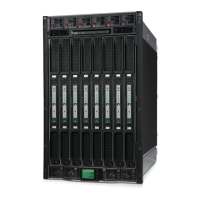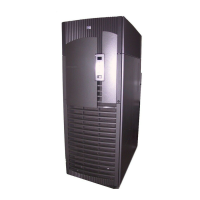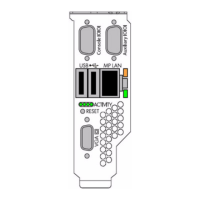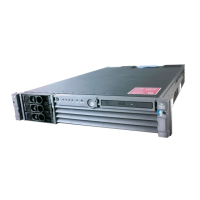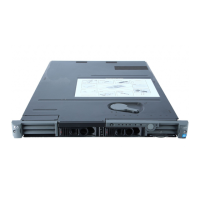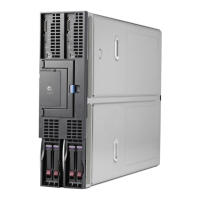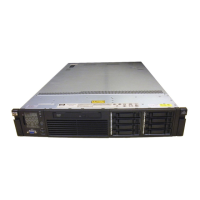




Do you have a question about the HP Integrity Superdome 2 16-socket and is the answer not in the manual?
Connect to the Onboard Administrator remotely via Telnet or Secure Shell sessions.
Connect to the Onboard Administrator locally via a serial port during initial setup.
Details the reasons and benefits of using the CLI for managing the Onboard Administrator.
Lists commands not applicable to HP Integrity Superdome 2 Server Blades.
Defines user account classifications, capabilities, and privilege levels within the OA.
Clears the terminal screen for a cleaner interface.
Exits the Command Line Interface session.
Provides usage and help text for commands.
Exits the command line interface.
Exits the command line interface.
Sets a user-defined name for the enclosure's rack.
Displays the current user-defined rack name setting.
Displays connected complexes, enclosures, and their network information.
Creates an SSH connection to another OA in a remote enclosure.
Collects and uploads system logs and files to a specified location.
Adds a new user account to the system.
Assigns bays to a user or group.
Disables a user account, logging out the user and preventing future logins.
Enables a previously disabled user account.
Shows the history of commands executed in the current session.
Sets the password for the current user or a specified user.
Displays detailed information about users and their access rights.
Disables certificate revocation checks.
Disables Two-Factor Authentication.
Downloads a CA certificate to validate user certificates for Two-Factor Authentication.
Displays the configuration details for Two-Factor Authentication.
Adds an LDAP certificate to the command line.
Assigns bays to a specified LDAP group.
Disables directory authentication.
Enables directory authentication.
Sets the LDAP group access level.
Sets the IP address or DNS name of the directory server.
Displays LDAP settings including status, server, port, and NT mapping.
Runs LDAP tests and optionally attempts to log in to the LDAP server.
Adds an HP SIM certificate on the command line.
Downloads an HP SIM SSO certificate from a specified IP address.
Enables or disables HP SIM SSO mode for trusted applications.
Displays current HP SIM SSO configuration.
Downloads a CA certificate to replace the current OA security certificate.
Forces the redundant OA to become the active OA.
Generates a PKCS#10 certificate request or a self-signed certificate.
Sends ICMP echo messages to a remote IP device to test connectivity.
Restores the Onboard Administrator to its factory defaults.
Ceases all prompting and verification when SCRIPT MODE is on.
Executes all SHOW commands in succession.
Shows the specified direct attached blade device serial number.
Displays users with serial console sessions in progress for each interconnect.
Displays a list of authenticated sessions on the OA.
Adds a DNS server IP address to the list of DNS servers.
Disables the ability of OA to give devices IP addresses using DHCP.
Enables OA to provide IP addresses to devices using DHCP.
Removes the DNS server specified by the IP address from the list.
Sets EBIPA settings including IP address, netmask, and gateway.
Displays EBIPA information for interconnects or blades.
Adds an IP address of a DNS server to the list.
Adds an IP address to receive SNMP traps.
Adds SSH keys to the Administrator local account.
Removes the authorized key file used for SSH login.
Disables the sending of emails when events occur.
Disables Enclosure IP Mode.
Disables HTTPS access to the Onboard Administrator.
Disables SSH access to the Onboard Administrator.
Disables SNMP support for the Onboard Administrator.
Downloads a saved configuration file from a specific IP host.
Enables the sending of alert emails when an event occurs.
Enables Enclosure IP Mode.
Enables HTTPS access to the Onboard Administrator.
Enables SSH support for the Onboard Administrator.
Enables SNMP Trap support for the Onboard Administrator.
Removes the IP address of a DNS server from the list.
Sets the email address where events are sent.
Sets the network default gateway.
Sets the Onboard Administrator name.
Configures IP settings for the OA to DHCP or static mode.
Displays Onboard Administrator network settings.
Displays SNMP configuration details.
Displays the key fingerprint of the OA host public key.
Clears the Onboard Administrator system log.
Disables extended enclosure information on the login page.
Disables Link Loss Failover for OA Redundancy.
Enables extended enclosure information on the login page.
Enables Link Loss Failover for OA Redundancy.
Powers off all Xbar Fabric modules.
Powers on all Xbar Fabric modules.
Resets the Onboard Administrator module.
Changes the enclosure name.
Sets the enclosure serial number.
Turns the UID LED of the enclosure on or off.
Turns the UID LED of specified IOX enclosures on or off.
Configures power settings to ensure a specified level of redundancy.
Turns power savings mode on or off.
Sets the time zone for the complex.
Displays the script required to recreate the enclosure settings.
Displays the current date, time, and time zone of the enclosure.
Displays information about and status of the specified enclosure fan.
Displays enclosure name, type, and OA hardware version.
Displays information about the Insight Display screen.
Displays the basic health and status of the enclosure subsystem.
Displays temperature sensor information for enclosure components.
Provides information on all field replaceable units within the enclosure.
Displays OA certificate, network, status, or USB mode information.
Displays information about the Onboard Administrator.
Disables access to the Primary or Secondary NTP server.
Disables time and date synchronization with a remote server.
Enables NTP support for the Onboard Administrator.
Ungracefully halts all processing across the HP Integrity Superdome 2 complex.
Changes the complex name.
Sets the date of the complex, including time and time zone.
Sets the primary server for time and date synchronization.
Sets the secondary server for time and date synchronization.
Displays product name, complex name, UUID, manufacturer, and firmware version.
Displays complex operational status information.
Configures the external NIC for auto-negotiation or forced link settings.
Sets the PowerDelay status for specified servers.
Turns a server blade UID LED on or off.
Displays detailed information about server blades.
Displays a brief description of all server blades accessible to the user.
Displays a brief description of all blades accessible to the user.
Displays the port mapping for the blade specified by the bay number.
Displays the PowerDelay status for server blades.
Displays power, health, thermal, and UID LED settings of server blades.
Displays temperature sensor information for blades.
Displays model, manufacturer, part number, serial number, and firmware revision.
Displays the IOX enclosure list.
Displays power information for specified IOX enclosures.
Displays IO expansion enclosure status information.
Assigns interconnects to an existing user or group.
Terminates a serial console session of a user on an interconnect.
Connects the user to the serial console of the interconnect.
Sends a request to power off the interconnect module.
Powers on the specified interconnect.
Resets the interconnect tray in the specified bay.
Sets the PowerDelay status for specified interconnects.
Turns an interconnect UID on or off.
Turns the UID LED of specified Xbar Fabric modules on or off.
Displays model, manufacturer, part number, serial number, and firmware revision.
Displays GPSM status information; UID state and health state.
Displays interconnect type, product name, width, part number, serial number, etc.
Displays the interconnect list.
Displays the port mapping for the interconnect specified by the bay number.
Displays the PowerDelay status for specified interconnects.
Displays interconnect status information; UID state and health state.
Displays model, manufacturer, part number, serial number, and firmware revision.
Displays the Xbar Fabric module list.
Displays Xbar Fabric module status information.
Displays DVD module model, manufacturer, part number, serial number, and EDC.
Displays DVD drive status information; UID state and health state.
Sets the DVD UID (Unit Identification LED) on or off.
Disables remote system logging.
Enables remote system logging.
Sets the IP port number for remote system log.
Sets the IP address or DNS name for remote system log messages.
Displays the remote syslog settings for the Onboard Administrator.
Tests remote system log settings by logging a test message.
Downloads a saved configuration file from a USB key.
Displays firmware images, scripts, and ISO images on the USB media.
Uploads a script to duplicate the current runtime configuration from USB.
Displays the Superdome 2 system iCAP status.
Allows setting configuration options, including notification email and iCAP ID.
Assigns partition configuration Administration privileges to a user or group.
Removes Partition Configuration Administration privileges from a user or group.
Assigns partition privilege rights to a user or group.
Unassigns partition privilege rights from a user or group.
Creates a new nPartition on the local complex.
Modifies attributes of an existing nPartition or partition specification.
Deletes a partition on a local or remote complex.
Displays information about a system complex or specific components.
Gracefully shuts down OS on a specified nPartition or virtual partition.
Powers on blades and interconnects in an nPartition and boots to UEFI.
Reboots the OS on the specified nPartition or virtual partition.
Connects or disconnects the DVD module to the specified partition.
Displays information about the DVD drive attached to the specified partition.
Displays information about the specified partitions.
Performs a transfer-of-control reset of the specified nPartition or virtual partition.
Changes default values of nPartition attributes or OS-specific attributes.
Changes authorizations for an OS running in an nPar or vPar.
Creates a new virtual partition using specified hardware resources.
Boots the specified virtual partition.
Modifies resources of a specified virtual partition.
Deletes a virtual partition previously created.
Displays information about one or more virtual partitions.
Clears the Forward Progress Log.
Clears the System Event Log.
Clears the console log for the specified partition.
Connects to the text console for the specified partition.
Launches the Forward Progress Log viewer.
Launches the live Event Log Viewer.
Launches the Console Log Viewer for the specified partition.
Launches the System Event Log viewer.
Manually acquits a specified component.
Manually deconfigures a specified component.
Displays errors experienced by DIMMs on a specified blade.
Manually indicts a specified component.
Lists acquitted indicted components with details.
Lists components that are deconfigured or have a pending request.
Launches the Health Repository viewer.
Lists all currently indicted components with details.
Lists installation and health history of a physical location.
Performs an active test of the CAMNet manageability fabric.
Performs an active test of the complex interconnect fabric.
Verifies global clock distribution and clock generator functionality.
Displays or clears the Core Analysis Engine event log.
Displays raw error logs generated by Error Logging Services.
Disables debugger ports on all complex partitions.
Enables debugger ports for 5 minutes.
Displays firmware versions of FRUs in the enclosure.
Displays complex bundle firmware versions and lists mismatched devices.
Displays partition firmware versions and lists mismatched blades.
Lists bundle revision and displays mismatches against configured versions.
Executes the firmware upgrade process on enclosure devices.
Installs partition firmware from a bundle to partitions or blades.
Describes messages displayed when update effects are reported.
Overview of firmware update process and its limitations.
All Superdome 2 platform firmware is contained in a single bundle.
Firmware update does not overwrite images unless REINSTALL flag is used.
Update actions must not harm partitions or install unintended firmware.
Targets firmware updates to a single offline partition.
Updates all partitions and unassigned blades in the system.
Updates a single blade not assigned to a partition.
Details warnings issued if partition firmware is incompatible with complex firmware.
Describes error messages and abort conditions during firmware updates.
Introduces online complex firmware updates for reduced downtime.
Lists server management services unavailable during online complex firmware updates.
Users are disconnected from OA during complex firmware updates.
No IPMI requests can be serviced until the update completes.
Describes how partition events are handled during management firmware unavailability.
Lists OS commands that may malfunction during online firmware updates.
Provides answers to common questions about online complex firmware updates.
Lists observations to help operators understand loss of server management features.
Lists files on the archive storage.
Removes individual or all files from the archive store.
Copies config, parconfig, debug log, or firmware bundle files.
Downloads a saved partition specification file from archive, IP host, or USB.
Uploads complex partition configuration to archive, URL, or USB.
Enables users to power on nPartitions.
Displays the Console Log viewer.
Accesses the nPartition text console.
Equivalent to SHOW FPL.
Enables users to control the power state of nPartitions.
Enables users to reset a partition.
Equivalent to SHOW SEL.
Enables users to TOC reset a partition.
Produces screen messages for enclosure events when SHOW DISPLAY EVENTS is enabled.
Displays error, warning, and status messages in the terminal interface.
Information to have available before contacting HP support.
Provides contact details for HP authorized resellers and technical support.
Recommends product registration for improvements and updates.
Provides contact information for submitting feedback about product documentation.
Recommends installing HP Insight Remote Support for monitoring and event diagnosis.
Details additions and changes made for the current edition.
Lists related documents such as the Partitioning Administrator Guide.
Explains typographical conventions used in the document.
Describes how event logs are generated and classified by severity.
Allows searching FPL and SEL log viewers using text strings.
Provides a way to see records as they occur, with filtering options.
Allows OA users to view event records stored in the FPL.
Allows OA users to view event records stored in the SEL.
Displays information from the HR database covering service and error events.
Records specifying that a component requires service.
Clears component indictment and deconfiguration statuses after servicing.
Lists components with current indictments.
Lists components that are deconfigured or have a pending deconfiguration request.
Lists components that have had indictments acquitted.
Allows viewing recent service history using the show acquit command.
Returns stored installation and health history of a physical location.
Communicates subcomponent health information via 'SubFru Isolation' sections.
Provides a list of supported Universal time zone settings.
Provides a list of supported African time zone settings.
Provides a list of supported Americas time zone settings.
Provides a list of supported Asian time zone settings.
Provides a list of supported Oceanic time zone settings.
Provides a list of supported European time zone settings.
Provides a list of supported Polar time zone settings.
Connect to the Onboard Administrator remotely via Telnet or Secure Shell sessions.
Connect to the Onboard Administrator locally via a serial port during initial setup.
Details the reasons and benefits of using the CLI for managing the Onboard Administrator.
Lists commands not applicable to HP Integrity Superdome 2 Server Blades.
Defines user account classifications, capabilities, and privilege levels within the OA.
Clears the terminal screen for a cleaner interface.
Exits the Command Line Interface session.
Provides usage and help text for commands.
Exits the command line interface.
Exits the command line interface.
Sets a user-defined name for the enclosure's rack.
Displays the current user-defined rack name setting.
Displays connected complexes, enclosures, and their network information.
Creates an SSH connection to another OA in a remote enclosure.
Collects and uploads system logs and files to a specified location.
Adds a new user account to the system.
Assigns bays to a user or group.
Disables a user account, logging out the user and preventing future logins.
Enables a previously disabled user account.
Shows the history of commands executed in the current session.
Sets the password for the current user or a specified user.
Displays detailed information about users and their access rights.
Disables certificate revocation checks.
Disables Two-Factor Authentication.
Downloads a CA certificate to validate user certificates for Two-Factor Authentication.
Displays the configuration details for Two-Factor Authentication.
Adds an LDAP certificate to the command line.
Assigns bays to a specified LDAP group.
Disables directory authentication.
Enables directory authentication.
Sets the LDAP group access level.
Sets the IP address or DNS name of the directory server.
Displays LDAP settings including status, server, port, and NT mapping.
Runs LDAP tests and optionally attempts to log in to the LDAP server.
Adds an HP SIM certificate on the command line.
Downloads an HP SIM SSO certificate from a specified IP address.
Enables or disables HP SIM SSO mode for trusted applications.
Displays current HP SIM SSO configuration.
Downloads a CA certificate to replace the current OA security certificate.
Forces the redundant OA to become the active OA.
Generates a PKCS#10 certificate request or a self-signed certificate.
Sends ICMP echo messages to a remote IP device to test connectivity.
Restores the Onboard Administrator to its factory defaults.
Ceases all prompting and verification when SCRIPT MODE is on.
Executes all SHOW commands in succession.
Shows the specified direct attached blade device serial number.
Displays users with serial console sessions in progress for each interconnect.
Displays a list of authenticated sessions on the OA.
Adds a DNS server IP address to the list of DNS servers.
Disables the ability of OA to give devices IP addresses using DHCP.
Enables OA to provide IP addresses to devices using DHCP.
Removes the DNS server specified by the IP address from the list.
Sets EBIPA settings including IP address, netmask, and gateway.
Displays EBIPA information for interconnects or blades.
Adds an IP address of a DNS server to the list.
Adds an IP address to receive SNMP traps.
Adds SSH keys to the Administrator local account.
Removes the authorized key file used for SSH login.
Disables the sending of emails when events occur.
Disables Enclosure IP Mode.
Disables HTTPS access to the Onboard Administrator.
Disables SSH access to the Onboard Administrator.
Disables SNMP support for the Onboard Administrator.
Downloads a saved configuration file from a specific IP host.
Enables the sending of alert emails when an event occurs.
Enables Enclosure IP Mode.
Enables HTTPS access to the Onboard Administrator.
Enables SSH support for the Onboard Administrator.
Enables SNMP Trap support for the Onboard Administrator.
Removes the IP address of a DNS server from the list.
Sets the email address where events are sent.
Sets the network default gateway.
Sets the Onboard Administrator name.
Configures IP settings for the OA to DHCP or static mode.
Displays Onboard Administrator network settings.
Displays SNMP configuration details.
Displays the key fingerprint of the OA host public key.
Clears the Onboard Administrator system log.
Disables extended enclosure information on the login page.
Disables Link Loss Failover for OA Redundancy.
Enables extended enclosure information on the login page.
Enables Link Loss Failover for OA Redundancy.
Powers off all Xbar Fabric modules.
Powers on all Xbar Fabric modules.
Resets the Onboard Administrator module.
Changes the enclosure name.
Sets the enclosure serial number.
Turns the UID LED of the enclosure on or off.
Turns the UID LED of specified IOX enclosures on or off.
Configures power settings to ensure a specified level of redundancy.
Turns power savings mode on or off.
Sets the time zone for the complex.
Displays the script required to recreate the enclosure settings.
Displays the current date, time, and time zone of the enclosure.
Displays information about and status of the specified enclosure fan.
Displays enclosure name, type, and OA hardware version.
Displays information about the Insight Display screen.
Displays the basic health and status of the enclosure subsystem.
Displays temperature sensor information for enclosure components.
Provides information on all field replaceable units within the enclosure.
Displays OA certificate, network, status, or USB mode information.
Displays information about the Onboard Administrator.
Disables access to the Primary or Secondary NTP server.
Disables time and date synchronization with a remote server.
Enables NTP support for the Onboard Administrator.
Ungracefully halts all processing across the HP Integrity Superdome 2 complex.
Changes the complex name.
Sets the date of the complex, including time and time zone.
Sets the primary server for time and date synchronization.
Sets the secondary server for time and date synchronization.
Displays product name, complex name, UUID, manufacturer, and firmware version.
Displays complex operational status information.
Configures the external NIC for auto-negotiation or forced link settings.
Sets the PowerDelay status for specified servers.
Turns a server blade UID LED on or off.
Displays detailed information about server blades.
Displays a brief description of all server blades accessible to the user.
Displays a brief description of all blades accessible to the user.
Displays the port mapping for the blade specified by the bay number.
Displays the PowerDelay status for server blades.
Displays power, health, thermal, and UID LED settings of server blades.
Displays temperature sensor information for blades.
Displays model, manufacturer, part number, serial number, and firmware revision.
Displays the IOX enclosure list.
Displays power information for specified IOX enclosures.
Displays IO expansion enclosure status information.
Assigns interconnects to an existing user or group.
Terminates a serial console session of a user on an interconnect.
Connects the user to the serial console of the interconnect.
Sends a request to power off the interconnect module.
Powers on the specified interconnect.
Resets the interconnect tray in the specified bay.
Sets the PowerDelay status for specified interconnects.
Turns an interconnect UID on or off.
Turns the UID LED of specified Xbar Fabric modules on or off.
Displays model, manufacturer, part number, serial number, and firmware revision.
Displays GPSM status information; UID state and health state.
Displays interconnect type, product name, width, part number, serial number, etc.
Displays the interconnect list.
Displays the port mapping for the interconnect specified by the bay number.
Displays the PowerDelay status for specified interconnects.
Displays interconnect status information; UID state and health state.
Displays model, manufacturer, part number, serial number, and firmware revision.
Displays the Xbar Fabric module list.
Displays Xbar Fabric module status information.
Displays DVD module model, manufacturer, part number, serial number, and EDC.
Displays DVD drive status information; UID state and health state.
Sets the DVD UID (Unit Identification LED) on or off.
Disables remote system logging.
Enables remote system logging.
Sets the IP port number for remote system log.
Sets the IP address or DNS name for remote system log messages.
Displays the remote syslog settings for the Onboard Administrator.
Tests remote system log settings by logging a test message.
Downloads a saved configuration file from a USB key.
Displays firmware images, scripts, and ISO images on the USB media.
Uploads a script to duplicate the current runtime configuration from USB.
Displays the Superdome 2 system iCAP status.
Allows setting configuration options, including notification email and iCAP ID.
Assigns partition configuration Administration privileges to a user or group.
Removes Partition Configuration Administration privileges from a user or group.
Assigns partition privilege rights to a user or group.
Unassigns partition privilege rights from a user or group.
Creates a new nPartition on the local complex.
Modifies attributes of an existing nPartition or partition specification.
Deletes a partition on a local or remote complex.
Displays information about a system complex or specific components.
Gracefully shuts down OS on a specified nPartition or virtual partition.
Powers on blades and interconnects in an nPartition and boots to UEFI.
Reboots the OS on the specified nPartition or virtual partition.
Connects or disconnects the DVD module to the specified partition.
Displays information about the DVD drive attached to the specified partition.
Displays information about the specified partitions.
Performs a transfer-of-control reset of the specified nPartition or virtual partition.
Changes default values of nPartition attributes or OS-specific attributes.
Changes authorizations for an OS running in an nPar or vPar.
Creates a new virtual partition using specified hardware resources.
Boots the specified virtual partition.
Modifies resources of a specified virtual partition.
Deletes a virtual partition previously created.
Displays information about one or more virtual partitions.
Clears the Forward Progress Log.
Clears the System Event Log.
Clears the console log for the specified partition.
Connects to the text console for the specified partition.
Launches the Forward Progress Log viewer.
Launches the live Event Log Viewer.
Launches the Console Log Viewer for the specified partition.
Launches the System Event Log viewer.
Manually acquits a specified component.
Manually deconfigures a specified component.
Displays errors experienced by DIMMs on a specified blade.
Manually indicts a specified component.
Lists acquitted indicted components with details.
Lists components that are deconfigured or have a pending request.
Launches the Health Repository viewer.
Lists all currently indicted components with details.
Lists installation and health history of a physical location.
Performs an active test of the CAMNet manageability fabric.
Performs an active test of the complex interconnect fabric.
Verifies global clock distribution and clock generator functionality.
Displays or clears the Core Analysis Engine event log.
Displays raw error logs generated by Error Logging Services.
Disables debugger ports on all complex partitions.
Enables debugger ports for 5 minutes.
Displays firmware versions of FRUs in the enclosure.
Displays complex bundle firmware versions and lists mismatched devices.
Displays partition firmware versions and lists mismatched blades.
Lists bundle revision and displays mismatches against configured versions.
Executes the firmware upgrade process on enclosure devices.
Installs partition firmware from a bundle to partitions or blades.
Describes messages displayed when update effects are reported.
Overview of firmware update process and its limitations.
All Superdome 2 platform firmware is contained in a single bundle.
Firmware update does not overwrite images unless REINSTALL flag is used.
Update actions must not harm partitions or install unintended firmware.
Targets firmware updates to a single offline partition.
Updates all partitions and unassigned blades in the system.
Updates a single blade not assigned to a partition.
Details warnings issued if partition firmware is incompatible with complex firmware.
Describes error messages and abort conditions during firmware updates.
Introduces online complex firmware updates for reduced downtime.
Lists server management services unavailable during online complex firmware updates.
Users are disconnected from OA during complex firmware updates.
No IPMI requests can be serviced until the update completes.
Describes how partition events are handled during management firmware unavailability.
Lists OS commands that may malfunction during online firmware updates.
Provides answers to common questions about online complex firmware updates.
Lists observations to help operators understand loss of server management features.
Lists files on the archive storage.
Removes individual or all files from the archive store.
Copies config, parconfig, debug log, or firmware bundle files.
Downloads a saved partition specification file from archive, IP host, or USB.
Uploads complex partition configuration to archive, URL, or USB.
Enables users to power on nPartitions.
Displays the Console Log viewer.
Accesses the nPartition text console.
Equivalent to SHOW FPL.
Enables users to control the power state of nPartitions.
Enables users to reset a partition.
Equivalent to SHOW SEL.
Enables users to TOC reset a partition.
Produces screen messages for enclosure events when SHOW DISPLAY EVENTS is enabled.
Displays error, warning, and status messages in the terminal interface.
Information to have available before contacting HP support.
Provides contact details for HP authorized resellers and technical support.
Recommends product registration for improvements and updates.
Provides contact information for submitting feedback about product documentation.
Recommends installing HP Insight Remote Support for monitoring and event diagnosis.
Details additions and changes made for the current edition.
Lists related documents such as the Partitioning Administrator Guide.
Explains typographical conventions used in the document.
Describes how event logs are generated and classified by severity.
Allows searching FPL and SEL log viewers using text strings.
Provides a way to see records as they occur, with filtering options.
Allows OA users to view event records stored in the FPL.
Allows OA users to view event records stored in the SEL.
Displays information from the HR database covering service and error events.
Records specifying that a component requires service.
Clears component indictment and deconfiguration statuses after servicing.
Lists components with current indictments.
Lists components that are deconfigured or have a pending deconfiguration request.
Lists components that have had indictments acquitted.
Allows viewing recent service history using the show acquit command.
Returns stored installation and health history of a physical location.
Communicates subcomponent health information via 'SubFru Isolation' sections.
Provides a list of supported Universal time zone settings.
Provides a list of supported African time zone settings.
Provides a list of supported Americas time zone settings.
Provides a list of supported Asian time zone settings.
Provides a list of supported Oceanic time zone settings.
Provides a list of supported European time zone settings.
Provides a list of supported Polar time zone settings.
